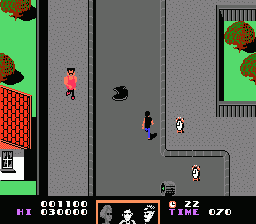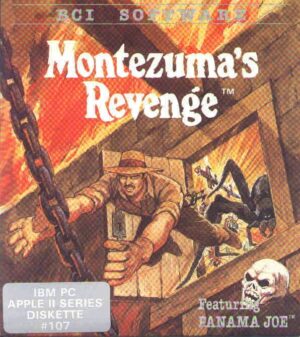Retro Replay Review
Gameplay
Back to the Future’s gameplay hinges on a relentless, forward-scrolling overhead view that forces you to keep Marty McFly in constant motion. As the screen advances at a fixed pace, you must dodge a variety of period-appropriate obstacles—bullies, hula-hoop girls, bumblebees, even park benches—each collision costing you a life and jeopardizing your mission. Layered atop this basic rush is the photographic timer: collect scattered clocks to halt the fading of Marty’s family portrait, a clever visual take on the film’s temporal paradox threat.
To break up the street-running monotony, the game deploys three distinctive arcade-style minigames. First, you sling milkshakes at oncoming toughs, timing each throw to knock them off balance. Next, you fend off amorous advances from Lorraine by deflecting floating hearts with your skateboard. Finally, you scramble to gather musical notes on stage, setting up Marty’s electrifying guitar solo at the high school dance. Each segment offers a fun change of pace, requiring quick reflexes and pattern memorization.
The finale returns to the chase motif, this time behind the wheel of the DeLorean. Swapping clocks for lightning-bolt power-ups, you guide the time machine through hazardous streets to generate the 1.21 gigawatts needed for temporal displacement. Precision driving and keen timing in collecting energy bolts make this capstone both exhilarating and unforgiving—cutting close to the wire perfectly echoes the source material’s “race against time” spirit.
Graphics
On the NES hardware, Back to the Future delivers blocky but charming visuals that capture the mid-’50s Hill Valley aesthetic. Background buildings sport pastel hues and simple detail, evoking a nostalgic Main Street, while the sprites for Marty, the DeLorean, and assorted obstacles read clearly even in the heat of high-speed play. The color palette stays faithful to the era, balancing eras: Marty’s red vest and blue jeans stand out nicely against muted sidewalks.
The minigames lean into cartoony exaggeration—milkshakes arc through the air in bright whites and pinks, hearts drift across the screen in bold reds, and musical notes pop visually to signal their importance. Though there’s minimal animation beyond a few frames of movement, each segment has its own distinct look that helps the player immediately understand the new objectives without confusing onscreen clutter.
Scrolling during the street sections is mostly smooth, though the hardware occasionally struggles if too many sprites overlap. Pop-in can occur when a cluster of obstacles enters view, demanding quick adjustments from the player. Despite these hiccups, the overall presentation is colorful, functional, and appropriately nostalgic for fans of 8-bit era design.
Story
Back to the Future distills the film’s time-travel premise into a streamlined arcade adventure. You’re dropped into 1955 with one simple goal: ensure Marty’s parents meet and fall in love so he can return to 1985. This high-concept setup is conveyed entirely through the gameplay mechanics—no elaborate cutscenes or dialogue trees—yet the ticking photo and flashing “Erase?” warning deliver the narrative stakes in real time.
Each stage represents a key moment in the film’s timeline: running the streets of Hill Valley, standing up to Biff’s gang, and finally powering the DeLorean for takeoff. The minigames often play loose with the story (hurling milkshakes or deflecting kisses), but they serve as lighthearted vignettes that break up the frantic chase. Though the plot elements are sparse, the essence of Marty’s dilemma shines through in every obstacle and power-up.
Die-hard fans might wish for more direct references—character cameos or voice clips are notably absent—but the game’s faithfulness lies in its sense of urgency and the looming threat of erasure. By tying each gameplay mechanic to the film’s core narrative hook, LJN manages to turn a popular movie into an interactive race against time.
Overall Experience
Back to the Future offers an engaging challenge for players who enjoy fast-paced, score-driven arcade action with a nostalgic twist. The constant forward momentum creates a tension that few licensed titles of its era manage to sustain. When you nail a clean run through the streets, nail enough milkshake throws, and race the DeLorean to 88 mph, the payoff captures the heart of the film’s climactic moments.
However, modern gamers may find the difficulty spikes and repetitive street sections frustrating. Lives are precious, checkpoints are scarce, and mastering the fixed scroll demands split-second reactions. The minigames help break things up, but they too hinge on trial-and-error memorization. Patience and practice are prerequisites for success.
For retro enthusiasts and Back to the Future fans, this title remains a curious slice of cinematic gaming history. It may not boast the depth or polish of today’s licensed adventures, but its inventive use of countdown photography, themed minigames, and time-machine finale deliver an experience that’s both distinctive and nostalgically rewarding. Just be prepared for its old-school unforgiving streak.
 Retro Replay Retro Replay gaming reviews, news, emulation, geek stuff and more!
Retro Replay Retro Replay gaming reviews, news, emulation, geek stuff and more!









Reviews
There are no reviews yet.